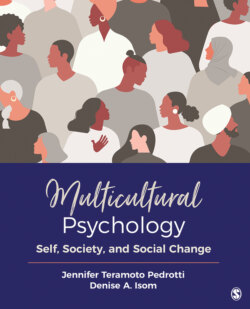Читать книгу Multicultural Psychology - Jennifer T. Pedrotti - Страница 37
На сайте Литреса книга снята с продажи.
Asian Americans
ОглавлениеFor Asian Americans, that very term raises a number of issues, from the way in which it obscures the extraordinary diversity contained within this group (more than 20 nations, cultures, histories, etc. in the United States alone) to the use of “American” for a population ironically seen as “the perpetual foreigner.” Neither of the authors of this text can count the number of times Asian American students have told us the story of being praised for their command of the English language and of being asked, “Where are you from?” followed by, “Where are you really from?” when the answer of Chicago or New Orleans or Fresno isn’t enough. Asian Americans are often seen as not really American; they are often betrayed in popular culture with heavy accents, but little ethnic or national specificity, they are “Asian,” and thus other.
Early encounters, and the beginning of Asian racial constructions in the United States, began in the 1800s with the Chinese and Japanese. In Orientals: Asian Americans in Popular Culture, Lee (1999) argues that there are six “faces” or images that make up the racial construction of Asian Americans—the “pollutant,” the “coolie,” the deviant, the yellow peril, the model minority, and the “gook,” each one constructed at “a specific historical moment, marked by a shift in class relations accompanied by cultural crisis” (p. 8). He goes on to write that
some studies attribute hostilities towards Asian immigrants directly to economic competition and the creation of an ethnically defined segmented labor market. They provide us with an economic framework for understanding the dynamics of class and race and a map of the economic terrain on which anti-Asian hostility has been built (pp. 5–6).
In other words, the coolie representations of the Chinese were developed at a time when the Chinese laborer was seen as a threat to White labor. Politically, these representations formed the backdrop to the 1882 Chinese Exclusion Act, which barred all Chinese immigration; it was the first federal law that targeted a specific ethnic group. Similarly, a report from the US government’s Commission on Wartime Relocation and Internment of Civilians, “Personal Justice Denied” (Kashima, 1997), concluded that the economic threat that White West Coast farmers felt from Japanese agricultural success formed “part of the impetus for the incarceration of the Japanese” (p. 42) during World War II. Figure 2.4 shows a timeline of Asian American history.
Figure 2.4 Asian American Timeline
Asian Americans may soon become the fastest growing immigrant group in the United States. According to Pew research (Lopez, Ruiz, & Patten, 2017), the Asian immigrant population grew 72% from 2000 to 2015.
